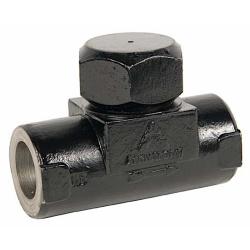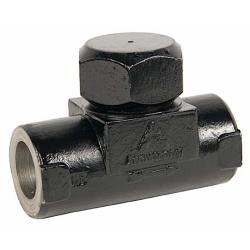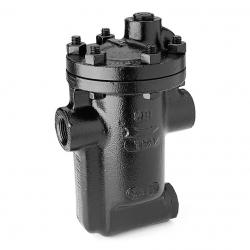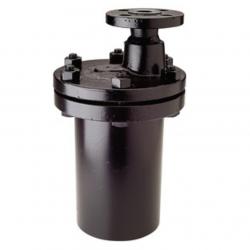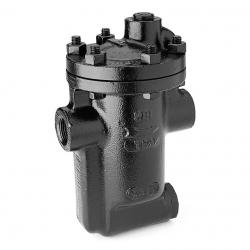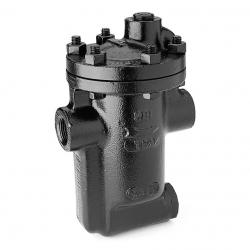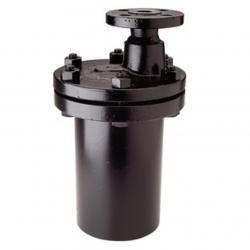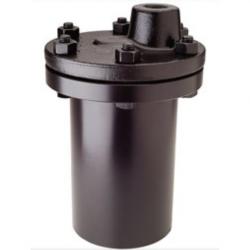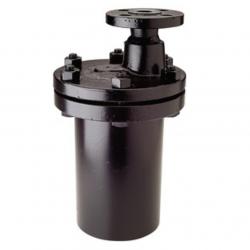52psi
Armstrong International
View:
Active Filters :
- Brand: Armstrong International
- Maximum Operating Pressure (psi): 52psi 600psi 900psi 1200psi
Part #:501-A21861
- CD-33 Series Disc Steam TrapFor steam service up to 600 psig (42 barg)
Capacities to 2,500 lb/hr (1,134 kg/hr).
The Armstrong CD-33 is a disc-style trap designed to control the traps cycle rate. By reducing the cycle rate, the Armstrong CD-33 extends its service life well beyond that of typical disc traps. This enhanced performance minimizes maintenance time and greatly reduces steam costs.
The CD-33 is designed with three discharge ports, which offer stable disc operation to extend operating life. The capacities of the Armstrong CD-33 have been engineered specifically for the following applications large steam main drips, process equipment and HVAC heating equipment on constant pressure.
The CD-33L (low capacity) trap is designed for the low capacity applications of steam main drips and steam tracing lines. By ensuring that the capacities are designed to suit the applicationand are not oversizedthe CD-33 Series will last longer than other disc traps with excessive capacity ratings. Heres why
• Three-discharge port design
• Minimum wear with controlled cycling
• Freeze resistant
• Hardened seat and disc
Qty:
Part #:501-A21862
- CD-33 Series Disc Steam TrapFor steam service up to 600 psig (42 barg)
Capacities to 2,500 lb/hr (1,134 kg/hr).
The Armstrong CD-33 is a disc-style trap designed to control the traps cycle rate. By reducing the cycle rate, the Armstrong CD-33 extends its service life well beyond that of typical disc traps. This enhanced performance minimizes maintenance time and greatly reduces steam costs.
The CD-33 is designed with three discharge ports, which offer stable disc operation to extend operating life. The capacities of the Armstrong CD-33 have been engineered specifically for the following applications large steam main drips, process equipment and HVAC heating equipment on constant pressure.
The CD-33L (low capacity) trap is designed for the low capacity applications of steam main drips and steam tracing lines. By ensuring that the capacities are designed to suit the applicationand are not oversizedthe CD-33 Series will last longer than other disc traps with excessive capacity ratings. Heres why
• Three-discharge port design
• Minimum wear with controlled cycling
• Freeze resistant
• Hardened seat and disc
Qty:
Part #:501-B4046
- CD-40 and CD-60 Series Controlled Disc Steam TrapsFor pressures to 600 psig (41 barg)
Capacities to 2,850 lb/hr (1 295 kg/hr)
Armstrong CD-40 and CD-60 Series controlled disc traps contain a replaceable capsule, making it possible to renew a worn trap by simply replacing the capsule. A heating chamber in the shell ensures consistent operation. This steam jacket provides a relatively constant temperature in the control chamber regardless of ambient conditions. Cycling rate is controlled and does not increase when the trap is exposed to cold winds, rain or snow. CD-40 Series traps are also available with optional integral .045 perforated stainless steel strainer screens. CD-60 Series traps contain integral strainers with ratios of open area to inside area of pipe that equal or exceed those of most separate Y-type strainers.
Qty:
Part #:501-B4908
- CD-40 and CD-60 Series Controlled Disc Steam TrapsFor pressures to 600 psig (41 barg)
Capacities to 2,850 lb/hr (1 295 kg/hr)
Armstrong CD-40 and CD-60 Series controlled disc traps contain a replaceable capsule, making it possible to renew a worn trap by simply replacing the capsule. A heating chamber in the shell ensures consistent operation. This steam jacket provides a relatively constant temperature in the control chamber regardless of ambient conditions. Cycling rate is controlled and does not increase when the trap is exposed to cold winds, rain or snow. CD-40 Series traps are also available with optional integral .045 perforated stainless steel strainer screens. CD-60 Series traps contain integral strainers with ratios of open area to inside area of pipe that equal or exceed those of most separate Y-type strainers.
Qty:
Part #:501-B5662
- CD-33 Series Disc Steam TrapFor steam service up to 600 psig (42 barg)
Capacities to 2,500 lb/hr (1,134 kg/hr).
The Armstrong CD-33 is a disc-style trap designed to control the traps cycle rate. By reducing the cycle rate, the Armstrong CD-33 extends its service life well beyond that of typical disc traps. This enhanced performance minimizes maintenance time and greatly reduces steam costs.
The CD-33 is designed with three discharge ports, which offer stable disc operation to extend operating life. The capacities of the Armstrong CD-33 have been engineered specifically for the following applications large steam main drips, process equipment and HVAC heating equipment on constant pressure.
The CD-33L (low capacity) trap is designed for the low capacity applications of steam main drips and steam tracing lines. By ensuring that the capacities are designed to suit the applicationand are not oversizedthe CD-33 Series will last longer than other disc traps with excessive capacity ratings. Heres why
• Three-discharge port design
• Minimum wear with controlled cycling
• Freeze resistant
• Hardened seat and disc
Qty:
Part #:501-B5663
- CD-33 Series Disc Steam TrapFor steam service up to 600 psig (42 barg)
Capacities to 2,500 lb/hr (1,134 kg/hr).
The Armstrong CD-33 is a disc-style trap designed to control the traps cycle rate. By reducing the cycle rate, the Armstrong CD-33 extends its service life well beyond that of typical disc traps. This enhanced performance minimizes maintenance time and greatly reduces steam costs.
The CD-33 is designed with three discharge ports, which offer stable disc operation to extend operating life. The capacities of the Armstrong CD-33 have been engineered specifically for the following applications large steam main drips, process equipment and HVAC heating equipment on constant pressure.
The CD-33L (low capacity) trap is designed for the low capacity applications of steam main drips and steam tracing lines. By ensuring that the capacities are designed to suit the applicationand are not oversizedthe CD-33 Series will last longer than other disc traps with excessive capacity ratings. Heres why
• Three-discharge port design
• Minimum wear with controlled cycling
• Freeze resistant
• Hardened seat and disc
Qty:
Part #:501-B5664
- CD-33 Series Disc Steam TrapFor steam service up to 600 psig (42 barg)
Capacities to 2,500 lb/hr (1,134 kg/hr).
The Armstrong CD-33 is a disc-style trap designed to control the traps cycle rate. By reducing the cycle rate, the Armstrong CD-33 extends its service life well beyond that of typical disc traps. This enhanced performance minimizes maintenance time and greatly reduces steam costs.
The CD-33 is designed with three discharge ports, which offer stable disc operation to extend operating life. The capacities of the Armstrong CD-33 have been engineered specifically for the following applications large steam main drips, process equipment and HVAC heating equipment on constant pressure.
The CD-33L (low capacity) trap is designed for the low capacity applications of steam main drips and steam tracing lines. By ensuring that the capacities are designed to suit the applicationand are not oversizedthe CD-33 Series will last longer than other disc traps with excessive capacity ratings. Heres why
• Three-discharge port design
• Minimum wear with controlled cycling
• Freeze resistant
• Hardened seat and disc
Qty:
Part #:501-B5666
- CD-33 Series Disc Steam TrapFor steam service up to 600 psig (42 barg)
Capacities to 2,500 lb/hr (1,134 kg/hr).
The Armstrong CD-33 is a disc-style trap designed to control the traps cycle rate. By reducing the cycle rate, the Armstrong CD-33 extends its service life well beyond that of typical disc traps. This enhanced performance minimizes maintenance time and greatly reduces steam costs.
The CD-33 is designed with three discharge ports, which offer stable disc operation to extend operating life. The capacities of the Armstrong CD-33 have been engineered specifically for the following applications large steam main drips, process equipment and HVAC heating equipment on constant pressure.
The CD-33L (low capacity) trap is designed for the low capacity applications of steam main drips and steam tracing lines. By ensuring that the capacities are designed to suit the applicationand are not oversizedthe CD-33 Series will last longer than other disc traps with excessive capacity ratings. Heres why
• Three-discharge port design
• Minimum wear with controlled cycling
• Freeze resistant
• Hardened seat and disc
Qty:
Part #:501-B5667
- CD-33 Series Disc Steam TrapFor steam service up to 600 psig (42 barg)
Capacities to 2,500 lb/hr (1,134 kg/hr).
The Armstrong CD-33 is a disc-style trap designed to control the traps cycle rate. By reducing the cycle rate, the Armstrong CD-33 extends its service life well beyond that of typical disc traps. This enhanced performance minimizes maintenance time and greatly reduces steam costs.
The CD-33 is designed with three discharge ports, which offer stable disc operation to extend operating life. The capacities of the Armstrong CD-33 have been engineered specifically for the following applications large steam main drips, process equipment and HVAC heating equipment on constant pressure.
The CD-33L (low capacity) trap is designed for the low capacity applications of steam main drips and steam tracing lines. By ensuring that the capacities are designed to suit the applicationand are not oversizedthe CD-33 Series will last longer than other disc traps with excessive capacity ratings. Heres why
• Three-discharge port design
• Minimum wear with controlled cycling
• Freeze resistant
• Hardened seat and disc
Qty:
Part #:501-D500525
- Inverted Bucket Steam TrapsEnergy efficient because it's so reliable
The inverted bucket is the most reliable steam trap operating principle known. The heart of its simple design is a unique leverage system that multiplies the force provided by the bucket to open the valve against pressure.
Since the bucket is open at the bottom, it resists damage from water hammer, and wear points are heavily reinforced for long life. The inverted bucket has only two moving parts-the valve lever assembly and the bucket. That means no fixed points, no complicated linkage. Nothing to stick, bind or clog.
Conserves energy even in the presence of wear
Armstrong inverted bucket steam traps open and close based on the difference in density between condensate and steam-the inverted bucket principle. They open and close gently, minimizing wear. This simple fact means that inverted buckets are subject to less wear than some other types of traps.
In fact, as an Armstrong inverted bucket trap wears, its tight seal actually improves. The valve and seat of the Armstrong trap provide essentially line contact-resulting in a tight seal because the entire closing force is concentrated on one narrow seating ring.
An Armstrong inverted bucket steam trap continues to operate efficiently with use. Gradual wear slightly increases the diameter of the seat and alters the shape and diameter of the valve. But, as this occurs, a tight seal is still preserved-the ball merely seats itself more deeply.
Corrosion-resistant parts
The stainless steel valve and seat of the Armstrong inverted bucket steam trap are individually ground and lapped together in matched sets. All other working parts are wear- and corrosion-resistant stainless steel.
Venting of air and CO2
The Armstrong inverted bucket provides continuous automatic air and CO2 venting with no cooling lag or threat of air binding.
Operation against back pressure
The Armstrong inverted bucket has excellent performance against back pressure. It has no adverse effect on inverted bucket operation other than to reduce its capacity by the low differential. The bucket simply requires less force to pull the valve open and cycle the trap.
Freedom from dirt problems
Armstrong designed its inverted bucket to be virtually free of dirt problems. The valve and seat are at the top of the trap, far away from the larger particles of dirt, which fall to the bottom. Here, the up-and-down action of the bucket pulverizes them.
Since the valve of an inverted bucket is either fully closed or open, dirt particles pass freely. And the swift flow of condensate from under the bucket's edge creates a unique self-scrubbing action that sweeps dirt out of the trap.
Qty:
Part #:501-D500574
- Inverted Bucket Steam TrapsEnergy efficient because it's so reliable
The inverted bucket is the most reliable steam trap operating principle known. The heart of its simple design is a unique leverage system that multiplies the force provided by the bucket to open the valve against pressure.
Since the bucket is open at the bottom, it resists damage from water hammer, and wear points are heavily reinforced for long life. The inverted bucket has only two moving parts-the valve lever assembly and the bucket. That means no fixed points, no complicated linkage. Nothing to stick, bind or clog.
Conserves energy even in the presence of wear
Armstrong inverted bucket steam traps open and close based on the difference in density between condensate and steam-the inverted bucket principle. They open and close gently, minimizing wear. This simple fact means that inverted buckets are subject to less wear than some other types of traps.
In fact, as an Armstrong inverted bucket trap wears, its tight seal actually improves. The valve and seat of the Armstrong trap provide essentially line contact-resulting in a tight seal because the entire closing force is concentrated on one narrow seating ring.
An Armstrong inverted bucket steam trap continues to operate efficiently with use. Gradual wear slightly increases the diameter of the seat and alters the shape and diameter of the valve. But, as this occurs, a tight seal is still preserved-the ball merely seats itself more deeply.
Corrosion-resistant parts
The stainless steel valve and seat of the Armstrong inverted bucket steam trap are individually ground and lapped together in matched sets. All other working parts are wear- and corrosion-resistant stainless steel.
Venting of air and CO2
The Armstrong inverted bucket provides continuous automatic air and CO2 venting with no cooling lag or threat of air binding.
Operation against back pressure
The Armstrong inverted bucket has excellent performance against back pressure. It has no adverse effect on inverted bucket operation other than to reduce its capacity by the low differential. The bucket simply requires less force to pull the valve open and cycle the trap.
Freedom from dirt problems
Armstrong designed its inverted bucket to be virtually free of dirt problems. The valve and seat are at the top of the trap, far away from the larger particles of dirt, which fall to the bottom. Here, the up-and-down action of the bucket pulverizes them.
Since the valve of an inverted bucket is either fully closed or open, dirt particles pass freely. And the swift flow of condensate from under the bucket's edge creates a unique self-scrubbing action that sweeps dirt out of the trap.
Qty:
Part #:501-D500768
- Inverted Bucket Steam TrapsEnergy efficient because it's so reliable
The inverted bucket is the most reliable steam trap operating principle known. The heart of its simple design is a unique leverage system that multiplies the force provided by the bucket to open the valve against pressure.
Since the bucket is open at the bottom, it resists damage from water hammer, and wear points are heavily reinforced for long life. The inverted bucket has only two moving parts-the valve lever assembly and the bucket. That means no fixed points, no complicated linkage. Nothing to stick, bind or clog.
Conserves energy even in the presence of wear
Armstrong inverted bucket steam traps open and close based on the difference in density between condensate and steam-the inverted bucket principle. They open and close gently, minimizing wear. This simple fact means that inverted buckets are subject to less wear than some other types of traps.
In fact, as an Armstrong inverted bucket trap wears, its tight seal actually improves. The valve and seat of the Armstrong trap provide essentially line contact-resulting in a tight seal because the entire closing force is concentrated on one narrow seating ring.
An Armstrong inverted bucket steam trap continues to operate efficiently with use. Gradual wear slightly increases the diameter of the seat and alters the shape and diameter of the valve. But, as this occurs, a tight seal is still preserved-the ball merely seats itself more deeply.
Corrosion-resistant parts
The stainless steel valve and seat of the Armstrong inverted bucket steam trap are individually ground and lapped together in matched sets. All other working parts are wear- and corrosion-resistant stainless steel.
Venting of air and CO2
The Armstrong inverted bucket provides continuous automatic air and CO2 venting with no cooling lag or threat of air binding.
Operation against back pressure
The Armstrong inverted bucket has excellent performance against back pressure. It has no adverse effect on inverted bucket operation other than to reduce its capacity by the low differential. The bucket simply requires less force to pull the valve open and cycle the trap.
Freedom from dirt problems
Armstrong designed its inverted bucket to be virtually free of dirt problems. The valve and seat are at the top of the trap, far away from the larger particles of dirt, which fall to the bottom. Here, the up-and-down action of the bucket pulverizes them.
Since the valve of an inverted bucket is either fully closed or open, dirt particles pass freely. And the swift flow of condensate from under the bucket's edge creates a unique self-scrubbing action that sweeps dirt out of the trap.
Qty:
Part #:501-D501026
- Inverted Bucket Steam TrapsEnergy efficient because it's so reliable
The inverted bucket is the most reliable steam trap operating principle known. The heart of its simple design is a unique leverage system that multiplies the force provided by the bucket to open the valve against pressure.
Since the bucket is open at the bottom, it resists damage from water hammer, and wear points are heavily reinforced for long life. The inverted bucket has only two moving parts-the valve lever assembly and the bucket. That means no fixed points, no complicated linkage. Nothing to stick, bind or clog.
Conserves energy even in the presence of wear
Armstrong inverted bucket steam traps open and close based on the difference in density between condensate and steam-the inverted bucket principle. They open and close gently, minimizing wear. This simple fact means that inverted buckets are subject to less wear than some other types of traps.
In fact, as an Armstrong inverted bucket trap wears, its tight seal actually improves. The valve and seat of the Armstrong trap provide essentially line contact-resulting in a tight seal because the entire closing force is concentrated on one narrow seating ring.
An Armstrong inverted bucket steam trap continues to operate efficiently with use. Gradual wear slightly increases the diameter of the seat and alters the shape and diameter of the valve. But, as this occurs, a tight seal is still preserved-the ball merely seats itself more deeply.
Corrosion-resistant parts
The stainless steel valve and seat of the Armstrong inverted bucket steam trap are individually ground and lapped together in matched sets. All other working parts are wear- and corrosion-resistant stainless steel.
Venting of air and CO2
The Armstrong inverted bucket provides continuous automatic air and CO2 venting with no cooling lag or threat of air binding.
Operation against back pressure
The Armstrong inverted bucket has excellent performance against back pressure. It has no adverse effect on inverted bucket operation other than to reduce its capacity by the low differential. The bucket simply requires less force to pull the valve open and cycle the trap.
Freedom from dirt problems
Armstrong designed its inverted bucket to be virtually free of dirt problems. The valve and seat are at the top of the trap, far away from the larger particles of dirt, which fall to the bottom. Here, the up-and-down action of the bucket pulverizes them.
Since the valve of an inverted bucket is either fully closed or open, dirt particles pass freely. And the swift flow of condensate from under the bucket's edge creates a unique self-scrubbing action that sweeps dirt out of the trap.
Qty:
Part #:501-D501210
- Inverted Bucket Steam TrapsEnergy efficient because it's so reliable
The inverted bucket is the most reliable steam trap operating principle known. The heart of its simple design is a unique leverage system that multiplies the force provided by the bucket to open the valve against pressure.
Since the bucket is open at the bottom, it resists damage from water hammer, and wear points are heavily reinforced for long life. The inverted bucket has only two moving parts-the valve lever assembly and the bucket. That means no fixed points, no complicated linkage. Nothing to stick, bind or clog.
Conserves energy even in the presence of wear
Armstrong inverted bucket steam traps open and close based on the difference in density between condensate and steam-the inverted bucket principle. They open and close gently, minimizing wear. This simple fact means that inverted buckets are subject to less wear than some other types of traps.
In fact, as an Armstrong inverted bucket trap wears, its tight seal actually improves. The valve and seat of the Armstrong trap provide essentially line contact-resulting in a tight seal because the entire closing force is concentrated on one narrow seating ring.
An Armstrong inverted bucket steam trap continues to operate efficiently with use. Gradual wear slightly increases the diameter of the seat and alters the shape and diameter of the valve. But, as this occurs, a tight seal is still preserved-the ball merely seats itself more deeply.
Corrosion-resistant parts
The stainless steel valve and seat of the Armstrong inverted bucket steam trap are individually ground and lapped together in matched sets. All other working parts are wear- and corrosion-resistant stainless steel.
Venting of air and CO2
The Armstrong inverted bucket provides continuous automatic air and CO2 venting with no cooling lag or threat of air binding.
Operation against back pressure
The Armstrong inverted bucket has excellent performance against back pressure. It has no adverse effect on inverted bucket operation other than to reduce its capacity by the low differential. The bucket simply requires less force to pull the valve open and cycle the trap.
Freedom from dirt problems
Armstrong designed its inverted bucket to be virtually free of dirt problems. The valve and seat are at the top of the trap, far away from the larger particles of dirt, which fall to the bottom. Here, the up-and-down action of the bucket pulverizes them.
Since the valve of an inverted bucket is either fully closed or open, dirt particles pass freely. And the swift flow of condensate from under the bucket's edge creates a unique self-scrubbing action that sweeps dirt out of the trap.
Qty:
Part #:501-D501481
- Inverted Bucket Steam TrapsEnergy efficient because it's so reliable
The inverted bucket is the most reliable steam trap operating principle known. The heart of its simple design is a unique leverage system that multiplies the force provided by the bucket to open the valve against pressure.
Since the bucket is open at the bottom, it resists damage from water hammer, and wear points are heavily reinforced for long life. The inverted bucket has only two moving parts-the valve lever assembly and the bucket. That means no fixed points, no complicated linkage. Nothing to stick, bind or clog.
Conserves energy even in the presence of wear
Armstrong inverted bucket steam traps open and close based on the difference in density between condensate and steam-the inverted bucket principle. They open and close gently, minimizing wear. This simple fact means that inverted buckets are subject to less wear than some other types of traps.
In fact, as an Armstrong inverted bucket trap wears, its tight seal actually improves. The valve and seat of the Armstrong trap provide essentially line contact-resulting in a tight seal because the entire closing force is concentrated on one narrow seating ring.
An Armstrong inverted bucket steam trap continues to operate efficiently with use. Gradual wear slightly increases the diameter of the seat and alters the shape and diameter of the valve. But, as this occurs, a tight seal is still preserved-the ball merely seats itself more deeply.
Corrosion-resistant parts
The stainless steel valve and seat of the Armstrong inverted bucket steam trap are individually ground and lapped together in matched sets. All other working parts are wear- and corrosion-resistant stainless steel.
Venting of air and CO2
The Armstrong inverted bucket provides continuous automatic air and CO2 venting with no cooling lag or threat of air binding.
Operation against back pressure
The Armstrong inverted bucket has excellent performance against back pressure. It has no adverse effect on inverted bucket operation other than to reduce its capacity by the low differential. The bucket simply requires less force to pull the valve open and cycle the trap.
Freedom from dirt problems
Armstrong designed its inverted bucket to be virtually free of dirt problems. The valve and seat are at the top of the trap, far away from the larger particles of dirt, which fall to the bottom. Here, the up-and-down action of the bucket pulverizes them.
Since the valve of an inverted bucket is either fully closed or open, dirt particles pass freely. And the swift flow of condensate from under the bucket's edge creates a unique self-scrubbing action that sweeps dirt out of the trap.
Qty:
Part #:501-D501505
- Inverted Bucket Steam TrapsEnergy efficient because it's so reliable
The inverted bucket is the most reliable steam trap operating principle known. The heart of its simple design is a unique leverage system that multiplies the force provided by the bucket to open the valve against pressure.
Since the bucket is open at the bottom, it resists damage from water hammer, and wear points are heavily reinforced for long life. The inverted bucket has only two moving parts-the valve lever assembly and the bucket. That means no fixed points, no complicated linkage. Nothing to stick, bind or clog.
Conserves energy even in the presence of wear
Armstrong inverted bucket steam traps open and close based on the difference in density between condensate and steam-the inverted bucket principle. They open and close gently, minimizing wear. This simple fact means that inverted buckets are subject to less wear than some other types of traps.
In fact, as an Armstrong inverted bucket trap wears, its tight seal actually improves. The valve and seat of the Armstrong trap provide essentially line contact-resulting in a tight seal because the entire closing force is concentrated on one narrow seating ring.
An Armstrong inverted bucket steam trap continues to operate efficiently with use. Gradual wear slightly increases the diameter of the seat and alters the shape and diameter of the valve. But, as this occurs, a tight seal is still preserved-the ball merely seats itself more deeply.
Corrosion-resistant parts
The stainless steel valve and seat of the Armstrong inverted bucket steam trap are individually ground and lapped together in matched sets. All other working parts are wear- and corrosion-resistant stainless steel.
Venting of air and CO2
The Armstrong inverted bucket provides continuous automatic air and CO2 venting with no cooling lag or threat of air binding.
Operation against back pressure
The Armstrong inverted bucket has excellent performance against back pressure. It has no adverse effect on inverted bucket operation other than to reduce its capacity by the low differential. The bucket simply requires less force to pull the valve open and cycle the trap.
Freedom from dirt problems
Armstrong designed its inverted bucket to be virtually free of dirt problems. The valve and seat are at the top of the trap, far away from the larger particles of dirt, which fall to the bottom. Here, the up-and-down action of the bucket pulverizes them.
Since the valve of an inverted bucket is either fully closed or open, dirt particles pass freely. And the swift flow of condensate from under the bucket's edge creates a unique self-scrubbing action that sweeps dirt out of the trap.
Qty:
Part #:501-D501844
- Inverted Bucket Steam TrapsEnergy efficient because it's so reliable
The inverted bucket is the most reliable steam trap operating principle known. The heart of its simple design is a unique leverage system that multiplies the force provided by the bucket to open the valve against pressure.
Since the bucket is open at the bottom, it resists damage from water hammer, and wear points are heavily reinforced for long life. The inverted bucket has only two moving parts-the valve lever assembly and the bucket. That means no fixed points, no complicated linkage. Nothing to stick, bind or clog.
Conserves energy even in the presence of wear
Armstrong inverted bucket steam traps open and close based on the difference in density between condensate and steam-the inverted bucket principle. They open and close gently, minimizing wear. This simple fact means that inverted buckets are subject to less wear than some other types of traps.
In fact, as an Armstrong inverted bucket trap wears, its tight seal actually improves. The valve and seat of the Armstrong trap provide essentially line contact-resulting in a tight seal because the entire closing force is concentrated on one narrow seating ring.
An Armstrong inverted bucket steam trap continues to operate efficiently with use. Gradual wear slightly increases the diameter of the seat and alters the shape and diameter of the valve. But, as this occurs, a tight seal is still preserved-the ball merely seats itself more deeply.
Corrosion-resistant parts
The stainless steel valve and seat of the Armstrong inverted bucket steam trap are individually ground and lapped together in matched sets. All other working parts are wear- and corrosion-resistant stainless steel.
Venting of air and CO2
The Armstrong inverted bucket provides continuous automatic air and CO2 venting with no cooling lag or threat of air binding.
Operation against back pressure
The Armstrong inverted bucket has excellent performance against back pressure. It has no adverse effect on inverted bucket operation other than to reduce its capacity by the low differential. The bucket simply requires less force to pull the valve open and cycle the trap.
Freedom from dirt problems
Armstrong designed its inverted bucket to be virtually free of dirt problems. The valve and seat are at the top of the trap, far away from the larger particles of dirt, which fall to the bottom. Here, the up-and-down action of the bucket pulverizes them.
Since the valve of an inverted bucket is either fully closed or open, dirt particles pass freely. And the swift flow of condensate from under the bucket's edge creates a unique self-scrubbing action that sweeps dirt out of the trap.
Qty:
Part #:501-D502716
- Inverted Bucket Steam TrapsEnergy efficient because it's so reliable
The inverted bucket is the most reliable steam trap operating principle known. The heart of its simple design is a unique leverage system that multiplies the force provided by the bucket to open the valve against pressure.
Since the bucket is open at the bottom, it resists damage from water hammer, and wear points are heavily reinforced for long life. The inverted bucket has only two moving parts-the valve lever assembly and the bucket. That means no fixed points, no complicated linkage. Nothing to stick, bind or clog.
Conserves energy even in the presence of wear
Armstrong inverted bucket steam traps open and close based on the difference in density between condensate and steam-the inverted bucket principle. They open and close gently, minimizing wear. This simple fact means that inverted buckets are subject to less wear than some other types of traps.
In fact, as an Armstrong inverted bucket trap wears, its tight seal actually improves. The valve and seat of the Armstrong trap provide essentially line contact-resulting in a tight seal because the entire closing force is concentrated on one narrow seating ring.
An Armstrong inverted bucket steam trap continues to operate efficiently with use. Gradual wear slightly increases the diameter of the seat and alters the shape and diameter of the valve. But, as this occurs, a tight seal is still preserved-the ball merely seats itself more deeply.
Corrosion-resistant parts
The stainless steel valve and seat of the Armstrong inverted bucket steam trap are individually ground and lapped together in matched sets. All other working parts are wear- and corrosion-resistant stainless steel.
Venting of air and CO2
The Armstrong inverted bucket provides continuous automatic air and CO2 venting with no cooling lag or threat of air binding.
Operation against back pressure
The Armstrong inverted bucket has excellent performance against back pressure. It has no adverse effect on inverted bucket operation other than to reduce its capacity by the low differential. The bucket simply requires less force to pull the valve open and cycle the trap.
Freedom from dirt problems
Armstrong designed its inverted bucket to be virtually free of dirt problems. The valve and seat are at the top of the trap, far away from the larger particles of dirt, which fall to the bottom. Here, the up-and-down action of the bucket pulverizes them.
Since the valve of an inverted bucket is either fully closed or open, dirt particles pass freely. And the swift flow of condensate from under the bucket's edge creates a unique self-scrubbing action that sweeps dirt out of the trap.
Qty:
Part #:501-D502769
- Inverted Bucket Steam TrapsEnergy efficient because it's so reliable
The inverted bucket is the most reliable steam trap operating principle known. The heart of its simple design is a unique leverage system that multiplies the force provided by the bucket to open the valve against pressure.
Since the bucket is open at the bottom, it resists damage from water hammer, and wear points are heavily reinforced for long life. The inverted bucket has only two moving parts-the valve lever assembly and the bucket. That means no fixed points, no complicated linkage. Nothing to stick, bind or clog.
Conserves energy even in the presence of wear
Armstrong inverted bucket steam traps open and close based on the difference in density between condensate and steam-the inverted bucket principle. They open and close gently, minimizing wear. This simple fact means that inverted buckets are subject to less wear than some other types of traps.
In fact, as an Armstrong inverted bucket trap wears, its tight seal actually improves. The valve and seat of the Armstrong trap provide essentially line contact-resulting in a tight seal because the entire closing force is concentrated on one narrow seating ring.
An Armstrong inverted bucket steam trap continues to operate efficiently with use. Gradual wear slightly increases the diameter of the seat and alters the shape and diameter of the valve. But, as this occurs, a tight seal is still preserved-the ball merely seats itself more deeply.
Corrosion-resistant parts
The stainless steel valve and seat of the Armstrong inverted bucket steam trap are individually ground and lapped together in matched sets. All other working parts are wear- and corrosion-resistant stainless steel.
Venting of air and CO2
The Armstrong inverted bucket provides continuous automatic air and CO2 venting with no cooling lag or threat of air binding.
Operation against back pressure
The Armstrong inverted bucket has excellent performance against back pressure. It has no adverse effect on inverted bucket operation other than to reduce its capacity by the low differential. The bucket simply requires less force to pull the valve open and cycle the trap.
Freedom from dirt problems
Armstrong designed its inverted bucket to be virtually free of dirt problems. The valve and seat are at the top of the trap, far away from the larger particles of dirt, which fall to the bottom. Here, the up-and-down action of the bucket pulverizes them.
Since the valve of an inverted bucket is either fully closed or open, dirt particles pass freely. And the swift flow of condensate from under the bucket's edge creates a unique self-scrubbing action that sweeps dirt out of the trap.
Qty:
Part #:501-D502868
- Inverted Bucket Steam TrapsEnergy efficient because it's so reliable
The inverted bucket is the most reliable steam trap operating principle known. The heart of its simple design is a unique leverage system that multiplies the force provided by the bucket to open the valve against pressure.
Since the bucket is open at the bottom, it resists damage from water hammer, and wear points are heavily reinforced for long life. The inverted bucket has only two moving parts-the valve lever assembly and the bucket. That means no fixed points, no complicated linkage. Nothing to stick, bind or clog.
Conserves energy even in the presence of wear
Armstrong inverted bucket steam traps open and close based on the difference in density between condensate and steam-the inverted bucket principle. They open and close gently, minimizing wear. This simple fact means that inverted buckets are subject to less wear than some other types of traps.
In fact, as an Armstrong inverted bucket trap wears, its tight seal actually improves. The valve and seat of the Armstrong trap provide essentially line contact-resulting in a tight seal because the entire closing force is concentrated on one narrow seating ring.
An Armstrong inverted bucket steam trap continues to operate efficiently with use. Gradual wear slightly increases the diameter of the seat and alters the shape and diameter of the valve. But, as this occurs, a tight seal is still preserved-the ball merely seats itself more deeply.
Corrosion-resistant parts
The stainless steel valve and seat of the Armstrong inverted bucket steam trap are individually ground and lapped together in matched sets. All other working parts are wear- and corrosion-resistant stainless steel.
Venting of air and CO2
The Armstrong inverted bucket provides continuous automatic air and CO2 venting with no cooling lag or threat of air binding.
Operation against back pressure
The Armstrong inverted bucket has excellent performance against back pressure. It has no adverse effect on inverted bucket operation other than to reduce its capacity by the low differential. The bucket simply requires less force to pull the valve open and cycle the trap.
Freedom from dirt problems
Armstrong designed its inverted bucket to be virtually free of dirt problems. The valve and seat are at the top of the trap, far away from the larger particles of dirt, which fall to the bottom. Here, the up-and-down action of the bucket pulverizes them.
Since the valve of an inverted bucket is either fully closed or open, dirt particles pass freely. And the swift flow of condensate from under the bucket's edge creates a unique self-scrubbing action that sweeps dirt out of the trap.
Qty:
Part #:501-D502880
- Inverted Bucket Steam TrapsEnergy efficient because it's so reliable
The inverted bucket is the most reliable steam trap operating principle known. The heart of its simple design is a unique leverage system that multiplies the force provided by the bucket to open the valve against pressure.
Since the bucket is open at the bottom, it resists damage from water hammer, and wear points are heavily reinforced for long life. The inverted bucket has only two moving parts-the valve lever assembly and the bucket. That means no fixed points, no complicated linkage. Nothing to stick, bind or clog.
Conserves energy even in the presence of wear
Armstrong inverted bucket steam traps open and close based on the difference in density between condensate and steam-the inverted bucket principle. They open and close gently, minimizing wear. This simple fact means that inverted buckets are subject to less wear than some other types of traps.
In fact, as an Armstrong inverted bucket trap wears, its tight seal actually improves. The valve and seat of the Armstrong trap provide essentially line contact-resulting in a tight seal because the entire closing force is concentrated on one narrow seating ring.
An Armstrong inverted bucket steam trap continues to operate efficiently with use. Gradual wear slightly increases the diameter of the seat and alters the shape and diameter of the valve. But, as this occurs, a tight seal is still preserved-the ball merely seats itself more deeply.
Corrosion-resistant parts
The stainless steel valve and seat of the Armstrong inverted bucket steam trap are individually ground and lapped together in matched sets. All other working parts are wear- and corrosion-resistant stainless steel.
Venting of air and CO2
The Armstrong inverted bucket provides continuous automatic air and CO2 venting with no cooling lag or threat of air binding.
Operation against back pressure
The Armstrong inverted bucket has excellent performance against back pressure. It has no adverse effect on inverted bucket operation other than to reduce its capacity by the low differential. The bucket simply requires less force to pull the valve open and cycle the trap.
Freedom from dirt problems
Armstrong designed its inverted bucket to be virtually free of dirt problems. The valve and seat are at the top of the trap, far away from the larger particles of dirt, which fall to the bottom. Here, the up-and-down action of the bucket pulverizes them.
Since the valve of an inverted bucket is either fully closed or open, dirt particles pass freely. And the swift flow of condensate from under the bucket's edge creates a unique self-scrubbing action that sweeps dirt out of the trap.
Qty:
Part #:501-D503256
- Inverted Bucket Steam TrapsEnergy efficient because it's so reliable
The inverted bucket is the most reliable steam trap operating principle known. The heart of its simple design is a unique leverage system that multiplies the force provided by the bucket to open the valve against pressure.
Since the bucket is open at the bottom, it resists damage from water hammer, and wear points are heavily reinforced for long life. The inverted bucket has only two moving parts-the valve lever assembly and the bucket. That means no fixed points, no complicated linkage. Nothing to stick, bind or clog.
Conserves energy even in the presence of wear
Armstrong inverted bucket steam traps open and close based on the difference in density between condensate and steam-the inverted bucket principle. They open and close gently, minimizing wear. This simple fact means that inverted buckets are subject to less wear than some other types of traps.
In fact, as an Armstrong inverted bucket trap wears, its tight seal actually improves. The valve and seat of the Armstrong trap provide essentially line contact-resulting in a tight seal because the entire closing force is concentrated on one narrow seating ring.
An Armstrong inverted bucket steam trap continues to operate efficiently with use. Gradual wear slightly increases the diameter of the seat and alters the shape and diameter of the valve. But, as this occurs, a tight seal is still preserved-the ball merely seats itself more deeply.
Corrosion-resistant parts
The stainless steel valve and seat of the Armstrong inverted bucket steam trap are individually ground and lapped together in matched sets. All other working parts are wear- and corrosion-resistant stainless steel.
Venting of air and CO2
The Armstrong inverted bucket provides continuous automatic air and CO2 venting with no cooling lag or threat of air binding.
Operation against back pressure
The Armstrong inverted bucket has excellent performance against back pressure. It has no adverse effect on inverted bucket operation other than to reduce its capacity by the low differential. The bucket simply requires less force to pull the valve open and cycle the trap.
Freedom from dirt problems
Armstrong designed its inverted bucket to be virtually free of dirt problems. The valve and seat are at the top of the trap, far away from the larger particles of dirt, which fall to the bottom. Here, the up-and-down action of the bucket pulverizes them.
Since the valve of an inverted bucket is either fully closed or open, dirt particles pass freely. And the swift flow of condensate from under the bucket's edge creates a unique self-scrubbing action that sweeps dirt out of the trap.
Qty:
Part #:501-D503380
- Inverted Bucket Steam TrapsEnergy efficient because it's so reliable
The inverted bucket is the most reliable steam trap operating principle known. The heart of its simple design is a unique leverage system that multiplies the force provided by the bucket to open the valve against pressure.
Since the bucket is open at the bottom, it resists damage from water hammer, and wear points are heavily reinforced for long life. The inverted bucket has only two moving parts-the valve lever assembly and the bucket. That means no fixed points, no complicated linkage. Nothing to stick, bind or clog.
Conserves energy even in the presence of wear
Armstrong inverted bucket steam traps open and close based on the difference in density between condensate and steam-the inverted bucket principle. They open and close gently, minimizing wear. This simple fact means that inverted buckets are subject to less wear than some other types of traps.
In fact, as an Armstrong inverted bucket trap wears, its tight seal actually improves. The valve and seat of the Armstrong trap provide essentially line contact-resulting in a tight seal because the entire closing force is concentrated on one narrow seating ring.
An Armstrong inverted bucket steam trap continues to operate efficiently with use. Gradual wear slightly increases the diameter of the seat and alters the shape and diameter of the valve. But, as this occurs, a tight seal is still preserved-the ball merely seats itself more deeply.
Corrosion-resistant parts
The stainless steel valve and seat of the Armstrong inverted bucket steam trap are individually ground and lapped together in matched sets. All other working parts are wear- and corrosion-resistant stainless steel.
Venting of air and CO2
The Armstrong inverted bucket provides continuous automatic air and CO2 venting with no cooling lag or threat of air binding.
Operation against back pressure
The Armstrong inverted bucket has excellent performance against back pressure. It has no adverse effect on inverted bucket operation other than to reduce its capacity by the low differential. The bucket simply requires less force to pull the valve open and cycle the trap.
Freedom from dirt problems
Armstrong designed its inverted bucket to be virtually free of dirt problems. The valve and seat are at the top of the trap, far away from the larger particles of dirt, which fall to the bottom. Here, the up-and-down action of the bucket pulverizes them.
Since the valve of an inverted bucket is either fully closed or open, dirt particles pass freely. And the swift flow of condensate from under the bucket's edge creates a unique self-scrubbing action that sweeps dirt out of the trap.
Qty:
Part #:501-D503718
- Inverted Bucket Steam TrapsEnergy efficient because it's so reliable
The inverted bucket is the most reliable steam trap operating principle known. The heart of its simple design is a unique leverage system that multiplies the force provided by the bucket to open the valve against pressure.
Since the bucket is open at the bottom, it resists damage from water hammer, and wear points are heavily reinforced for long life. The inverted bucket has only two moving parts-the valve lever assembly and the bucket. That means no fixed points, no complicated linkage. Nothing to stick, bind or clog.
Conserves energy even in the presence of wear
Armstrong inverted bucket steam traps open and close based on the difference in density between condensate and steam-the inverted bucket principle. They open and close gently, minimizing wear. This simple fact means that inverted buckets are subject to less wear than some other types of traps.
In fact, as an Armstrong inverted bucket trap wears, its tight seal actually improves. The valve and seat of the Armstrong trap provide essentially line contact-resulting in a tight seal because the entire closing force is concentrated on one narrow seating ring.
An Armstrong inverted bucket steam trap continues to operate efficiently with use. Gradual wear slightly increases the diameter of the seat and alters the shape and diameter of the valve. But, as this occurs, a tight seal is still preserved-the ball merely seats itself more deeply.
Corrosion-resistant parts
The stainless steel valve and seat of the Armstrong inverted bucket steam trap are individually ground and lapped together in matched sets. All other working parts are wear- and corrosion-resistant stainless steel.
Venting of air and CO2
The Armstrong inverted bucket provides continuous automatic air and CO2 venting with no cooling lag or threat of air binding.
Operation against back pressure
The Armstrong inverted bucket has excellent performance against back pressure. It has no adverse effect on inverted bucket operation other than to reduce its capacity by the low differential. The bucket simply requires less force to pull the valve open and cycle the trap.
Freedom from dirt problems
Armstrong designed its inverted bucket to be virtually free of dirt problems. The valve and seat are at the top of the trap, far away from the larger particles of dirt, which fall to the bottom. Here, the up-and-down action of the bucket pulverizes them.
Since the valve of an inverted bucket is either fully closed or open, dirt particles pass freely. And the swift flow of condensate from under the bucket's edge creates a unique self-scrubbing action that sweeps dirt out of the trap.
Qty:
Displaying: 1 - 24 of 82 Matching Items





